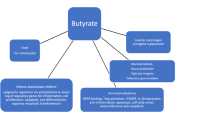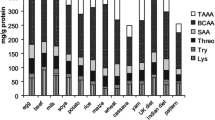Abstract
To our knowledge, no reports are available indicating the favorable effects of synbiotic bread consumption on blood lipid profiles among patients with type 2 diabetes mellitus (T2DM). This study was conducted to evaluate the effects of the daily consumption of synbiotic bread on blood lipid profiles of patients with T2DM. This randomized double-blinded controlled clinical trial was performed with 78 diabetic patients, aged 35–70 years. After a 2-week run-in period, subjects were randomly assigned to consume either synbiotic (n = 26), probiotic (n = 26) or control bread (n = 26) for 8 weeks. The synbiotic bread contained viable and heat-resistant probiotic Lactobacillus sporogenes (1 × 108 CFU) and 0.07 g inulin (HPX) as prebiotic per 1 g. The probiotic bread contained L. sporogenes (1 × 108 CFU) per 1 g. Patients were asked to consume the synbiotic, probiotic and control breads three times a day in a 40 g package for a total of 120 g/day. Biochemical measurements including blood lipid profiles were conducted before and after 8 weeks of intervention. Consumption of the synbiotic bread, compared to the probiotic and control breads, led to a significant decrease in serum TAG (P = 0.005), VLDL-C (P = 0.005), TC/HDL-C (P = 0.002) and a significant increase in serum HDL-C levels (P = 0.01). No significant effect of synbiotic bread consumption on FPG, TC, LDL-C and non-HDL-C levels was seen compared to the probiotic and control breads (P > 0.05). Trial registry code: http://www.irct.ir IRCT201311215623N13.

Similar content being viewed by others
Abbreviations
- HDL-C:
-
High density lipoprotein-cholesterol
- LDL-C:
-
Low density lipoprotein-cholesterol
- MUFA:
-
Monounsaturated fatty acid(s)
- PUFA:
-
Polyunsaturated fatty acid(s)
- SFA:
-
Saturated fatty acid(s)
- TAG:
-
Triacylglycerol(s)
- TC:
-
Total cholesterol
- VLDL-C:
-
Very low density lipoprotein-cholesterol
References
American Diabetes Association (2014) Diagnosis and classification of diabetes mellitus. Diabetes Care 37(Suppl 1):S81–S90
Ruggiero L, Castillo A, Quinn L, Hochwert M (2012) Translation of the diabetes prevention program’s lifestyle intervention: role of community health workers. Curr Diab Rep 12:127–137
Haghdoost AA, Rezazadeh-Kermani M, Sadghirad B, Baradaran HR (2009) Prevalence of type 2 diabetes in the Islamic Republic of Iran: systematic review and meta-analysis. East Mediterr Health J 15:591–599
Johnson M, Krosnick A, Carson P, McDade AM, Laraway K (1998) A retrospective chart review of uncontrolled use of metformin as an add-on therapy in type 2 diabetes. Clin Ther 20:691–698
Krentz AJ (2003) Lipoprotein abnormalities and their consequences for patients with type 2 diabetes. Diabetes Obes Metab 5(Suppl 1):S19–S27
Arca M, Pigna G, Favoccia C (2012) Mechanisms of diabetic dyslipidemia: relevance for atherogenesis. Curr Vasc Pharmacol 10:684–686
Yamashita T, Makino H, Nakatani R, Ohata Y, Miyamoto Y, Kishimoto I (2013) Renal insufficiency without albuminuria is associated with peripheral artery atherosclerosis and lipid metabolism disorders in patients with type 2 diabetes. J Atheroscler Thromb 20:790–797
Juanola-Falgarona M, Ibarrola-Jurado N, Salas-Salvado J, Rabassa-Soler A, Bullo M (2013) Design and methods of the GLYNDIET study; assessing the role of glycemic index on weight loss and metabolic risk markers. Nutr Hosp 28:382–390
Ajala O, English P, Pinkney J (2013) Systematic review and meta-analysis of different dietary approaches to the management of type 2 diabetes. Am J Clin Nutr 97:505–516
Masana L (2013) Pitavastatin in cardiometabolic disease: therapeutic profile. Cardiovasc Diabetol 12(Suppl 1):S2
Farvid MS, Siassi F, Jalali M, Hosseini M, Saadat N (2004) The impact of vitamin and/or mineral supplementation on lipid profiles in type 2 diabetes. Diabetes Res Clin Pract 65:21–28
Worthley DL, Le Leu RK, Whitehall VL, Conlon M, Christophersen C, Belobrajdic D et al (2009) A human, double-blind, placebo-controlled, crossover trial of prebiotic, probiotic, and synbiotic supplementation: effects on luminal, inflammatory, epigenetic, and epithelial biomarkers of colorectal cancer. Am J Clin Nutr 90:578–586
Ndagijimana M, Laghi L, Vitali B, Placucci G, Brigidi P, Guerzoni ME (2009) Effect of a synbiotic food consumption on human gut metabolic profiles evaluated by (1)H nuclear magnetic resonance spectroscopy. Int J Food Microbiol 134:147–153
Taghizadeh M, Hashemi T, Shakeri H, Abedi F, Sabihi SS, Alizadeh SA et al (2014) Synbiotic food consumption reduces levels of triacylglycerols and VLDL, but not cholesterol, LDL, or HDL in plasma from pregnant women. Lipids 49:155–161
Liong MT, Dunshea FR, Shah NP (2007) Effects of a synbiotic containing Lactobacillus acidophilus ATCC 4962 on plasma lipid profiles and morphology of erythrocytes in hypercholesterolaemic pigs on high- and low-fat diets. Br J Nutr 98:736–744
Pereira DI, Gibson GR (2002) Effects of consumption of probiotics and prebiotics on serum lipid levels in humans. Crit Rev Biochem Mol Biol 37:259–281
Vitali B, Ndagijimana M, Maccaferri S, Biagi E, Guerzoni ME, Brigidi P (2012) An in vitro evaluation of the effect of probiotics and prebiotics on the metabolic profile of human microbiota. Anaerobe 18:386–391
Lin MY, Chang FJ (2000) Antioxidative effect of intestinal bacteria Bifidobacterium longum ATCC 15708 and Lactobacillus acidophilus ATCC 4356. Dig Dis Sci 45:1617–1622
Lambert JM, Bongers RS, de Vos WM, Kleerebezem M (2008) Functional analysis of four bile salt hydrolase and penicillin acylase family members in Lactobacillus plantarum WCFS1. Appl Environ Microbiol 74:4719–4726
Lye HS, Rusul G, Liong MT (2010) Removal of cholesterol by lactobacilli via incorporation and conversion to coprostanol. J Dairy Sci 93:1383–1392
Asemi Z, Khorrami-Rad A, Alizadeh SA, Shakeri H, Esmaillzadeh A (2014) Effects of synbiotic food consumption on metabolic status of diabetic patients: a double-blind randomized cross-over controlled clinical trial. Clin Nutr 33:198–203
American Diabetes Association (2012) Diagnosis and classification of diabetes mellitus. Diabetes Care 35 Suppl 1:S64–S71
Endres JR, Clewell A, Jade KA, Farber T, Hauswirth J, Schauss AG (2009) Safety assessment of a proprietary preparation of a novel probiotic, Bacillus coagulans, as a food ingredient. Food Chem Toxicol 47:1231–1238
Asemi Z, Samimi M, Tabasi Z, Talebian P, Azarbad Z, Hydarzadeh Z et al (2012) Effect of daily consumption of probiotic yoghurt on lipid profiles in pregnant women: a randomized controlled clinical trial. J Matern Fetal Neonatal Med 25:1552–1556
Russo F, Riezzo G, Chiloiro M, De Michele G, Chimienti G, Marconi E et al (2010) Metabolic effects of a diet with inulin-enriched pasta in healthy young volunteers. Curr Pharm Des 16:825–831
St-Onge MP, Farnworth ER, Savard T, Chabot D, Mafu A, Jones PJ (2002) Kefir consumption does not alter plasma lipid levels or cholesterol fractional synthesis rates relative to milk in hyperlipidemic men: a randomized controlled trial [ISRCTN10820810]. BMC Complement Altern Med 2:1
Savard P, Lamarche B, Paradis ME, Thiboutot H, Laurin E, Roy D (2011) Impact of Bifidobacterium animalis subsp. lactis BB-12 and, Lactobacillus acidophilus LA-5-containing yoghurt, on fecal bacterial counts of healthy adults. Int J Food Microbiol 149:50–57
Trautwein EA, Rieckhoff D, Erbersdobler HF (1998) Dietary inulin lowers plasma cholesterol and triacylglycerol and alters biliary bile acid profile in hamsters. J Nutr 128:1937–1943
Williams CM (1999) Effects of inulin on lipid parameters in humans. J Nutr 129:1471S–1473S
Delzenne NM, Kok N (2001) Effects of fructans-type prebiotics on lipid metabolism. Am J Clin Nutr 73:456S–458S
Konstantinov SR, Smidt H, de Vos WM, Bruijns SC, Singh SK, Valence F et al (2008) S layer protein A of Lactobacillus acidophilus NCFM regulates immature dendritic cell and T cell functions. Proc Natl Acad Sci USA 105:19474–19479
Ouwehand AC, Tiihonen K, Saarinen M, Putaala H, Rautonen N (2009) Influence of a combination of Lactobacillus acidophilus NCFM and lactitol on healthy elderly: intestinal and immune parameters. Br J Nutr 101:367–375
Acknowledgments
The present study was supported by a Grant (No. 92107) from the Vice-Chancellor for Research, KUMS, Kashan, Iran. The authors would like to thank the staff of Gholabchi Clinic (Kashan, Iran) for their assistance in this project. We are grateful to the Research and Development Department of Sahar Bread Company, Tehran, Iran that provided probiotic and synbiotic products for the present study. Furthermore, we are grateful to the Research and Development Department of Tak Gene Zist Company, Tehran, Iran that provided Lactobacillus sporogenes for this study.
Conflict of interest
None of the authors had any personal or financial conflict of interest.
Author information
Authors and Affiliations
Corresponding author
About this article
Cite this article
Shakeri, H., Hadaegh, H., Abedi, F. et al. Consumption of Synbiotic Bread Decreases Triacylglycerol and VLDL Levels While Increasing HDL Levels in Serum from Patients with Type-2 Diabetes. Lipids 49, 695–701 (2014). https://doi.org/10.1007/s11745-014-3901-z
Received:
Accepted:
Published:
Issue Date:
DOI: https://doi.org/10.1007/s11745-014-3901-z




